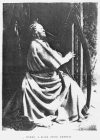
|

All kinds of present day harp traditions in all parts of Europe nowadays use a ‘right’ orientation. By this I mean that the harp is placed slightly to the right of the body's centreline, so that the eyes can see down the left hand side of the harp; the right hand controls the treble strings and the left hand controls the bass strings. This is like the orientation of the piano keyboard, with the bass to the left and the treble to the right.
By contrast, the Gaelic harp traditions of Ireland and Scotland used a ‘left’ orientation right up until their extinction in the 19th century. The treble was played by the left hand and the bass by the right.
This page assembles documentation attesting the Gaelic left-orientation. There are many more waiting to be added. Please let me know if I have missed out any important items.
19th century references

Patrick Byrne
The only Gaelic harper to be photographed was Patrick Byrne (1794 - 1863). In a series of calotypes by pioneering photographers Hill & Adamson, c.1845, he can clearly be seen holding his large Egan harp in a left orientation. Chambers' Edinburgh Journal of 1840 describes his playing:
|
“ This instrument it must be remembered is of peculiar structure. It contains about thirty brass wires, the twang of which give the music a striking metallic brilliancy. The high notes are given with the left hand, reserving the more powerful member for the deep chords of the bass. „ | |
Edward Bunting's 1840 book1 includes a chart of fingerings and ornaments performed by the old harpers. Though it's not clear whether these were collected by Bunting himself or by an informer, there are clear statements of which figures are to be played with which hands:
|
“
GRACES PERFORMED BY THE TREBLE OR LEFT HAND
| |

O'Hampsey
In his 1809 volume2, Edward Bunting published an engraved portrait of Denis O'Hampsey (1695 - 1807). You can see O'Hampsey holding the Downhill harp using a left orientation. This book also includes an engraved portrait of Arthur O’Neill who is also shown using a left orientation. There are a great many illustrations of harpers from the late 18th and the first decade of the 19th century, all of them using this left orientation. Some examples are another portrait of Denis O'Hampsey, a portrait of Patrick Quin, a portrait of William Archdeacon c. 1750.
18th century references
The blind Irish harper Arthur Ó Néill mentions orientation when describing his rheumatism:
|
“ ...my left hand, by which hand the treble on the Irish harp is generally peformed „ | |
In the 1790s Edward Bunting made an explicit note in his first field notebook, ms29. This is my hand copy of the lower half of page 81 (f38r); you can view a low-resolution facsimile of the manuscript at Queens University website. Direct download link.

17th century references
An oil painting by Reinhold Thimm, dated 1622, shows an Irish harper (probably Darby Scott) as part of a consort at the Danish royal court. He uses a left orientation. View an online facsimile.
16th century references
Medieval references
The three surviving medieval Gaelic harps all display areas of wear where the players' wrists or arms rested against the front edges of the soundbox3. These indicate not only the left orientation used to play these three instruments, but also the actual positioning of the hands on the instrument - and also perhaps by implication the height at which the instrument was held against the player:
For some insight into other wear from the playing position of the Queen Mary and Trinity harps, see my News Blog.

Shrine of
St. Mogue
The metal relief picture of David playing the harp from the Shrine of St Mogue (Breac Maedóic), usually dated c.1000AD, clearly shows a Gaelic harp being played using a left orientation. The left hand fingers are cleverly depicted behind the strings in the sculpture.
Simon Chadwick
